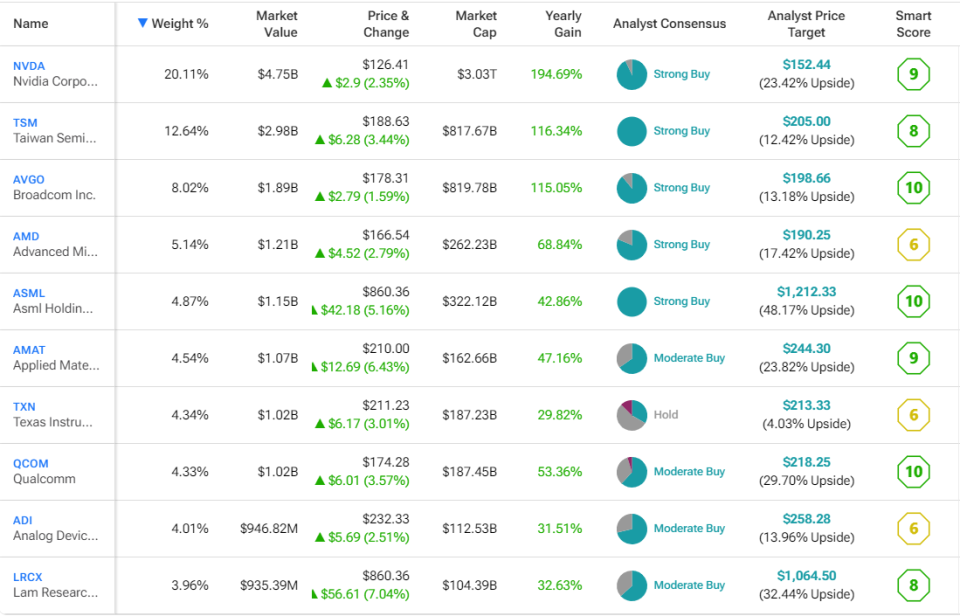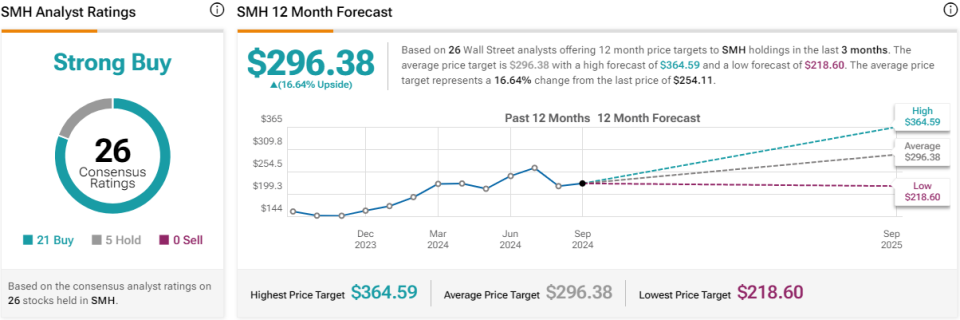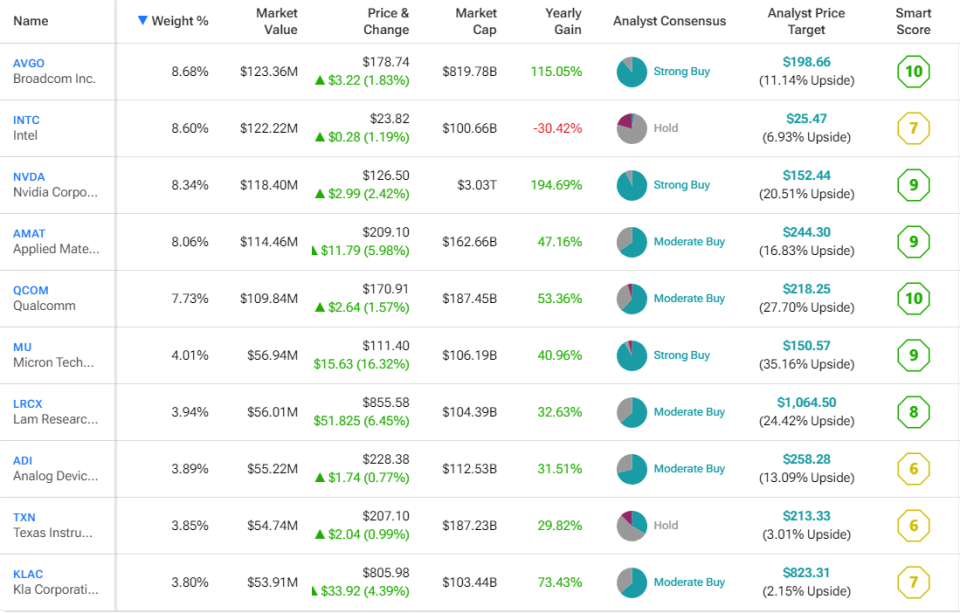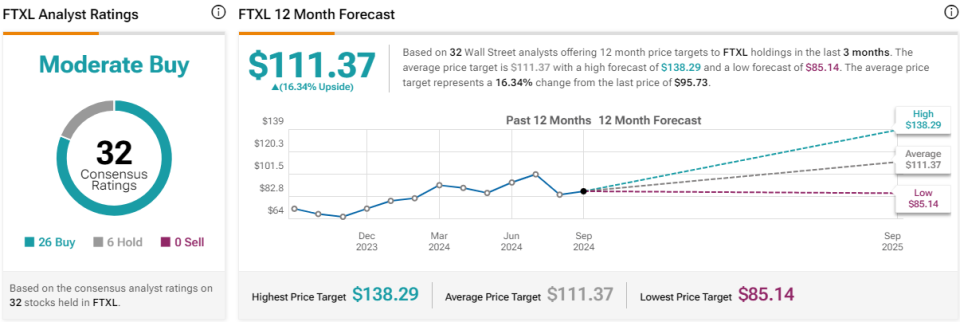After a brief dip this summer, semiconductor stocks are heating up again, as mainstays in the space like Micron (MU) post blowout earnings due to strong AI-related demand. The memory chip giant reported scorching 93.3% year-over-year revenue growth, and guided to record revenue of $8.7 billion for the upcoming quarter, well above analyst expectations.
Micron’s results gave a jolt to the sector and illustrate that AI demand is still strong. Investors can achieve diversified exposure to the semiconductor sector as a whole via an ETF, and there are many funds with different approaches to the space.
Let’s take a look at two popular semiconductor ETFs with different strategies — the Van Eck Semiconductor ETF (SMH) and the First Trust Nasdaq Semiconductor ETF (FTXL). Ultimately I land on SMH as being the best semiconductor ETF for investors.
Van Eck Semiconductor ETF (SMH)
SMH is the largest and most popular semiconductor-specific ETF, and with good reason, as I’ll explain below.
The $23.4 billion fund tracks an index called the “MVIS US Listed Semiconductor 25 Index”, which is intended to reflect the aggregate performance of companies involved in semiconductor production and equipment, according to Van Eck. Notably, SMH’s index methodology favors the largest companies in the industry, a key point which we will come back to later.
SMH is a fairly concentrated bet on semiconductors. The fund holds just 25 stocks, and its top 10 holdings account for 71.5% of assets. You can see an overview of SMH’s top 10 holdings below using TipRanks’ holdings tool.
As readers will note above, SMH has a massive 20.1% position in shares of Nvidia (NVDA). However, this large position has served it well, as Nvidia stock has risen nearly 200% in the past year.
The strong performance of Nvidia and other top holdings like Taiwan Semiconductor (TSM) and Broadcom (AVGO) have driven excellent returns for SMH stock and its investors. The ETF has been a monster performer over the past decade. As of August 31, 2024, SMH generated an annualized return of 22.5% over the past three years, an incredible annualized return of 34.8% over the past five years, and an enviable 26.6% 10-year annualized return. Those numbers trounce the broader market and even the tech-heavy but more generally allocated Invesco QQQ Trust (QQQ) over each time horizon.
Is SMH Stock a Buy, According to Analysts?
Turning to Wall Street, SMH earns a Strong Buy consensus rating based on 21 Buys, five Holds, and zero Sell rating assigned in the past three months. The average SMH stock price target of $296.38 implies about 16% potential upside from current levels.
I’m bullish on SMH based on its outstanding long-term performance, its portfolio of high-performing semiconductor stocks, and its bullish analyst outlook.
First Trust Nasdaq Semiconductor ETF (FTXL)
Now let’s take a look at the First Trust Nasdaq Semiconductor ETF (FTXL), another popular name in the space with $1.4 billion in AUM.
According to First Trust, FTXL invests in the Nasdaq U.S. Smart Semiconductor Index and seeks to replicate the holdings and weightings of this index. FTXL uses a modified, factor-weighted index “designed to provide exposure to U.S. companies within the semiconductor industry.” These factors include trailing 12-month return on assets, trailing 12-month gross income, and momentum.
This factor-weighted approach means that FTXL is a bit more diversified than SMH in that it holds 31 stocks with its top 10 holdings accounting for a lower 60.4% of net asset value. You can check out an overview of FTXL’s top 10 holdings from TipRanks’ Holdings Tool in the chart below.
As you can see, FTXL also holds Nvidia, but with an 8.3% weighting as opposed to SMH’s larger weighting of over 20%. Conversely, FTXL has more exposure to Intel; its second-largest holding, with an 8.6% position. Unfortunately, shares of Intel (INTC) are down 30.4% over the past year, which is one reason why FTXL has substantially outperformed SMH in recent times.
Over the past three years, the FTXL ETF has generated a solid annualized return of 11.6% (as of August 31), which is strong but lags far behind SMH’s 22.5% annualized return over the same timespan. Over the past five years, FTXL’s annualized return is better at 23.9% but still lags SMH’s exceptional 34.8% annualized return over that period. FTXL launched in 2016 so it does not yet have a 10-year track record of performance to compare to SMH’s.
It’s always important to evaluate fees, and FTXL is a bit more expensive to hold than SMH, with an expense ratio of 0.60%. SMH carries an expense ratio of 0.35%.
Is FTXL Stock a Buy According to Analysts?
Wall Street analysts afford FTXL a Moderate Buy consensus rating based on 26 Buys, six Holds, and zero Sell ratings assigned in the past three months. The average FTXL stock price target of $111.37 also implies 16% potential upside from current levels, same as SMH.
Overall, FTXL is a good ETF with a solid performance track record, but I am less bullish on it due to the fact that it has significantly lagged SMH’s performance over the past three and five years and also has a higher expense ratio. I land on a neutral rating here.
The Favored ETF Between SMH and FTXL
In my opinion, SMH is the clear winner in comparing these 2 popular semiconductor ETFs with different methodologies. While past performance is no guarantee of future results, the biggest semiconductor ETF has delivered stellar returns over the past three, five and 10 years, much more than FTXL.
While FTXL stock has been a decent performer, it has not been able to keep up with SMH stock. Based on this consistent gulf in results, it seems clear that SMH’s index methodology of favoring the largest semiconductor stocks has allowed it to capture more upside than FTXL’s factor-weighted approach. FTXL stock hasn’t capitalized as much on the strong performance of leading semi stocks like Nvidia and has also had more exposure to laggards like Intel. Of course, should Intel stock rebound, possibly due to a rumored takeover, FTXL’s performance could surge higher.
Nonetheless, based on these results, it seems that in the semiconductor space, going with the fastest horses is the better approach. I’m bullish on SMH as the best-in-class semiconductor ETF due to its superior performance, portfolio of strong semiconductor stocks, and its lower expense ratio.









